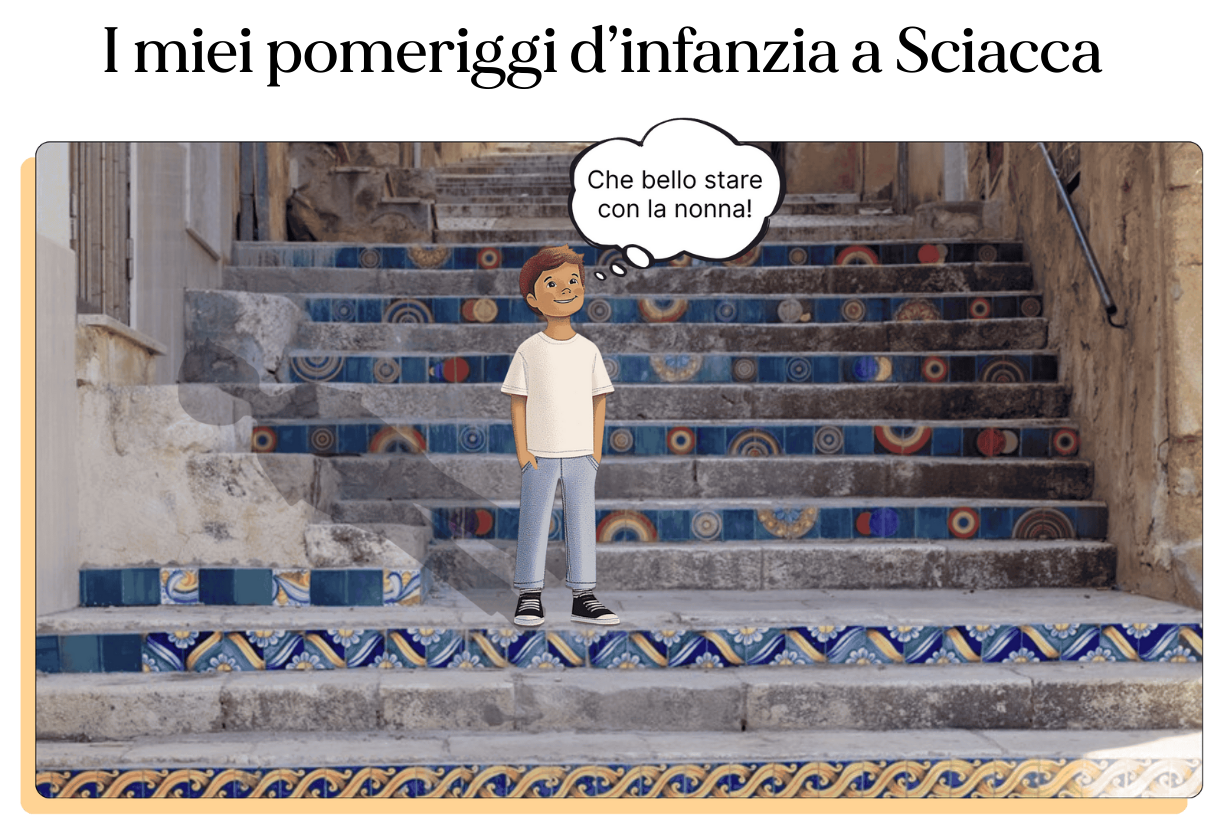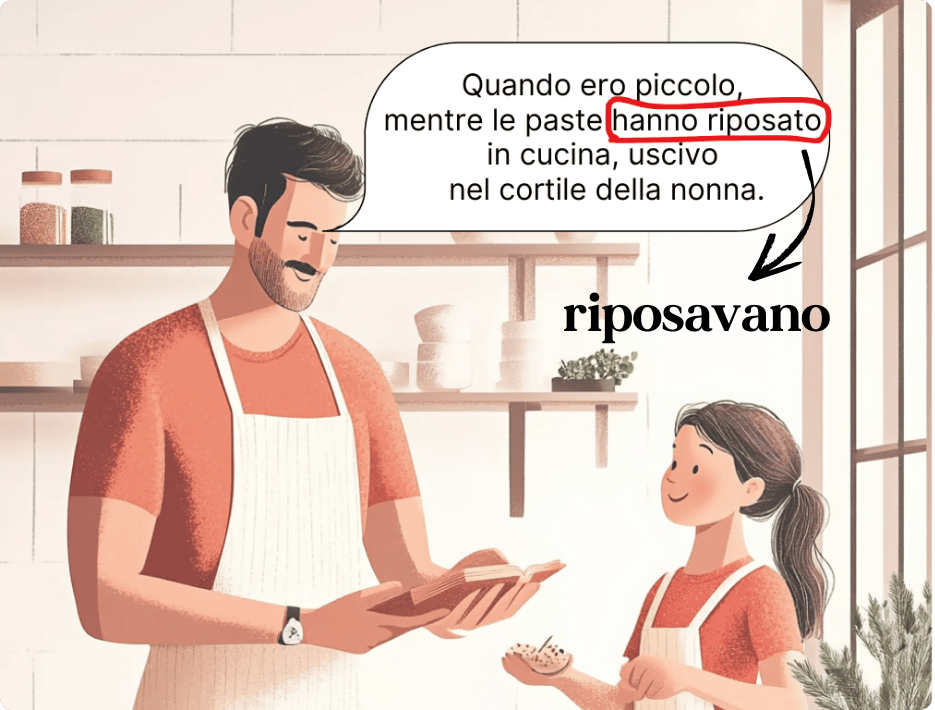Intro. What is the Imperfect Tense?
In Italian, the imperfect tense (l'imperfetto) is a past tense verb form.
The imperfect is the descriptive tense of the past, used to describe actions, situations, or physical or psychological conditions without specifying exactly when they began or ended. It provides context about past situations and describes habits or settings from the past.
Together with the present perfect (passato prossimo) or independently, it's the most frequently used tense for narrating actions or events that happened in the past.
1. Conjugation of the Imperfect Tense
1.1 Regular Verbs
Most Italian verbs have a regular imperfect conjugation.
The imperfect of regular verbs is formed by changing the infinitive endings -are, -ere, -ire as follows:
| Person | -ARE verbs | -ERE verbs | -IRE verbs |
|---|---|---|---|
| io (I) | -avo | -evo | -ivo |
| tu (you) | -avi | -evi | -ivi |
| lui/lei (he/she) | -ava | -eva | -iva |
| noi (we) | -avamo | -evamo | -ivamo |
| voi (you all) | -avate | -evate | -ivate |
| loro (they) | -avano | -evano | -ivano |
Examples:
Io parlavo (I was speaking/used to speak)
Tu guardavi (You were watching/used to watch)
Lui/lei metteva (He/she was putting/used to put)
Noi rimanevamo (We were staying/used to stay)
Voi sentivate (You all were hearing/used to hear)
Loro dormivano (They were sleeping/used to sleep)
Verbs ending in -isc like finire (to finish), capire (to understand), preferire (to prefer) change their endings regularly and become finivo, finivi, capiva, capivamo, preferivate, preferivano.
1.2 Imperfect of Avere and Essere
The verb essere (to be) forms the imperfect irregularly, while avere (to have) follows regular conjugation:
| Person | Essere (to be) | Avere (to have) |
|---|---|---|
| io (I) | ero | avevo |
| tu (you) | eri | avevi |
| lui/lei (he/she) | era | aveva |
| noi (we) | eravamo | avevamo |
| voi (you all) | eravate | avevate |
| loro (they) | erano | avevano |
1.3 Irregular Verbs in the Imperfect
The irregular verbs in the imperfect are fare (to do/make), dire (to say/tell), and bere (to drink).
The irregularity is in the initial part of the verb (the root). The endings remain the same as regular verbs:
| Person | Fare (to do/make) | Dire (to say/tell) | Bere (to drink) |
|---|---|---|---|
| io (I) | facevo | dicevo | bevevo |
| tu (you) | facevi | dicevi | bevevi |
| lui/lei (he/she) | faceva | diceva | beveva |
| noi (we) | facevamo | dicevamo | bevevamo |
| voi (you all) | facevate | dicevate | bevevate |
| loro (they) | facevano | dicevano | bevevano |
2. Uses of the Imperfect Tense
The imperfect is the descriptive tense of the past. It's used to describe the background against which past actions or events occur. The main functions are:
- describing past states, situations, and settings;
- narrating habitual or repeated actions in the past;
- describing actions in progress at a specific moment in the past;
- describing two or more simultaneous actions in the past;
- relating two simultaneous actions - one completed.
2.1 Describing Past States, Situations, and Settings
The imperfect is used to describe someone's emotional and physical state, to describe places, weather conditions, and past situations. It provides context without specifying when and if the action has ended.
Examples:
Luca era un bambino felice e tranquillo.
Luca was a happy and calm child.
Marco aveva i capelli biondi.
Marco had blond hair.
La casa era grande e luminosa.
The house was big and bright.
Pioveva molto ieri.
It was raining a lot yesterday.
Mara aveva un appartamento in periferia.
Mara had an apartment in the suburbs.
2.2 Narrating Habitual or Repeated Actions in the Past
The imperfect is used to describe actions that happened regularly or habitually in the past. It's usually accompanied by temporal expressions or frequency adverbs like da bambino (as a child), ogni giorno (every day), sempre (always), spesso (often), di solito (usually), in genere (generally).
Examples:
Da bambino ogni giorno facevo merenda con i nonni.
Every day as a child, I would have a snack with my grandparents.
In India facevo yoga ogni giorno.
In India, I used to do yoga every day.
Di solito io e Gianni mangiavamo insieme in pausa pranzo.
Usually, Gianni and I used to eat together during lunch break.
2.3 Describing an Action in Progress at a Specific Moment in the Past
The imperfect is used to indicate an action or event that was happening at a specific moment in the past. Using the imperfect emphasizes the duration of the action and completely omits the moment of beginning and end.
Examples:
Al tempo dell'università abitavo a Siena.
At the time of university, I lived in Siena.
Negli anni in cui vivevo in Svizzera, lavoravo in un ristorante.
During the years I lived in Switzerland, I worked in a restaurant.
Al mare facevo lunghe passeggiate sulla spiaggia.
At the seaside, I used to take long walks on the beach.
2.4 Describing Two or More Simultaneous Actions in the Past
The imperfect is also used to describe two or more actions happening simultaneously in the past, where it's not necessary to specify the beginning and end. They are generally connected by the conjunction mentre (while).
Examples:
Mentre lei dipingeva lui suonava la chitarra.
While she was painting, he was playing the guitar.
Spesso Anna ascoltava musica mentre cucinava.
Anna often listened to music while she was cooking.
Mentre guardavo la TV, mangiavo una pizza.
While I was watching TV, I was eating a pizza.
2.5 Relating Two Simultaneous Actions - One Completed
When an ongoing action in the past is interrupted by another sudden and specific action, it's necessary to combine the imperfect and the present perfect (passato prossimo) in the same sentence. The imperfect describes what was happening, while the present perfect introduces the event that changed the situation.
The typical structure of these sentences involves using mentre (while) followed by the imperfect to describe the continuous background action, or using quando (when) followed by the present perfect to indicate the specific event that creates the interruption.
Examples:
Mentre camminavamo nel parco, abbiamo visto un cane enorme.
While we were walking in the park, we saw a huge dog.
Stavo leggendo un libro quando è suonato il telefono.
I was reading a book when the phone rang.
3. Special Uses of the Imperfect Tense
The imperfect in Italian is also used with different values than just describing the past. The most common uses are:
- expressing a polite request - softening imperfect;
- expressing actions that you already intended to do.
3.1 Expressing a Polite Request - Softening Imperfect
The imperfect is sometimes used to express particular modal nuances, in place of the present and conditional tenses. In particular, in formal contexts, the imperfect is useful for softening the tone of requests. In some circumstances, using the imperfect conveys a certain embarrassment. It's usually used with verbs like volere (to want), preferire (to prefer), desiderare (to desire).
Examples:
Volevo sapere il prezzo di questo abito.
I wanted to know the price of this dress.
Signor Dante, volevo chiederLe un consiglio.
Mr. Dante, I wanted to ask you for some advice.
Desideravamo parlare con il Dottor Mirandi.
We wanted to speak with Dr. Mirandi.
3.2 Expressing Actions You Already Intended to Do
Using the imperfect expresses the intention of an action that hasn't yet occurred. This use contains a slight hint of uncertainty or an implicit request for confirmation from the interlocutor. The verb pensare (to think) is very commonly used.
Examples:
Pensavo di fare un giro in centro domani pomeriggio.
I was thinking of taking a walk downtown tomorrow afternoon.
Professor Lori, pensavo di venire nel Suo studio domani.
Professor Lori, I was thinking of coming to your office tomorrow.
Marco, pensavamo di chiamarti stasera.
Marco, we were thinking of calling you tonight.
4. Imperfect Tense in Context: Italian Short Story
Now that you've learned about the Italian imperfect tense, let's see it in action!
The following short story is rich with examples of the imperfect tense. As you read, try to identify how the imperfect tense is used to describe past habits, ongoing actions, and set the scene. Pay attention to the verbs in imperfect tense and notice how they create a vivid picture of childhood memories.

Da bambino, trascorrevo l’estate a Sciacca, a casa di nonna Carmela.
Casa di nonna Carmela si trovava in cima a una stradina stretta e tortuosa che a un bambino come me sembrava un sentiero segreto.
Le giornate a Sciacca erano lunghe e assolate. Nonna Carmela diceva sempre che il caldo di Sciacca era diverso dalle altre città, era più intenso. Dentro casa, però, si stava bene. I soffitti alti e le persiane socchiuse tenevano fuori il caldo più asfissiante e il pavimento di maiolica antica era sempre fresco sotto i piedi.
Nonna Carmela era un’esperta nel preparare paste di mandorle. Ogni volta che preparava quei dolcetti morbidi e profumati che si scioglievano in bocca diceva che il segreto era lasciare l’impasto a riposo per il giusto tempo, “come si fa con le cose importanti”. Mi teneva interi pomeriggi con lei in cucina. Aveva una pazienza infinita! Di solito, mentre le paste riposavano sul grande tavolo di legno al centro della cucina, uscivamo nel cortile, e stavamo ore all’ombra di un limone e di un vecchio fico che in agosto si riempiva di frutti dolcissimi. Mi faceva sedere su una sedia di vimini e mi raccontava le storie di quando era ragazza. Io restavo lì, seduto, e ascoltavo in silenzio.
Verso sera, nel cortile tirava sempre un vento leggero. “Mia madre diceva che il vento porta via i pensieri,” ripeteva spesso nonna Carmela, poi mi guardava e sorrideva.
Quando le paste erano pronte per essere cotte rientravamo in casa. Mentre le paste cuocevano in un vecchio forno a gas, io aspettavo impaziente e nel mentre la cucina si riempiva di un delizioso profumo di zucchero e mandorle. Poi le mangiavamo insieme, una lei e una io. Dopo il primo morso, mi chiedeva sempre: “Sono venute bene, vero?”. Lo diceva con un pizzico di divertimento e di malizia, perché sapeva che erano perfette.
A Sciacca il tempo si fermava. E da nonna Carmela, più che in qualsiasi altro posto, io mi sentivo davvero a casa.
5. Test Your Knowledge: Grammar Quiz
Test your skills and see what you’ve learned from this lesson on the Italian imperfect tense by completing the following quiz.
6. Frequently Asked Questions (FAQ) 🙋♀️
Are there other verbs that have an irregular imperfect besides dire, fare, bere?
Verbs ending in -urre like tradurre (to translate) and -orre like proporre (to propose) form the imperfect by introducing -uc and -on before the regular endings, becoming traducevo, proponevo.
What is the difference between using the imperfect and the present perfect of modal verbs?
The imperfect of modal verbs can express actions or events with an uncertain outcome. The present perfect indicates an action that has occurred with certainty and has concluded.
Examples:
Ieri Giacomo doveva chiamare Stefania. → action with uncertain outcome;
Ieri Giacomo ha dovuto chiamare Stefania. → certain action that occurred.
Is it possible to use the present perfect instead of the imperfect to describe past habits?
No, the imperfect is specifically used for habits and repeated actions in the past. The present perfect expresses a specific and completed action, not something habitual or ongoing.
What is the difference between imperfect and present perfect?
The imperfect describes continuous, habitual actions without a clear beginning or end. The present perfect focuses on specific and concluded actions or events that happened at a defined time.
How do you use mentre (while) or quando (when)?
Mentre + imperfect is used to introduce a continuous or ongoing action, often to relate two simultaneous ongoing actions: e.g., Mentre camminavo parlavo al telefono. (While I was walking, I was talking on the phone.)
Quando + present perfect is used to introduce the specific event that interrupts or occurs during the ongoing action: e.g., Camminavo quando Luisa mi ha telefonato. (I was walking when Luisa called me.)

Adriana Rossi is a certified teacher of Italian as a foreign language from Rome, Italy, and has been part of the Giulia team since 2024. With a Modern Literature degree and advanced studies in Modern Philology, she specializes in tracing the origins and evolution of Italian words, bringing expertise in diction and expressive reading to help preserve and share Italy’s linguistic heritage with learners worldwide.





